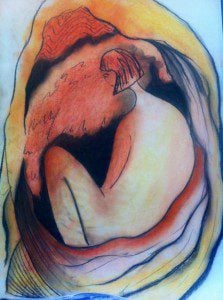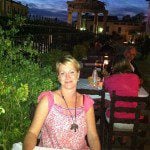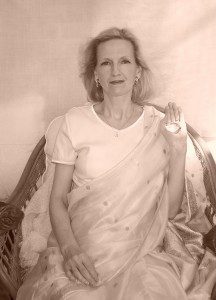Jassy Watson, mother of four, passionate organic gardener, artist and student of ancient history and religion. Spiritual seeker on the path of the Goddess.
As an avid gardener I witness the circle of life daily. I plant seeds, watch them grow, set seed, decay and then watch their progeny pop up all over the place. I find cocoons where caterpillars will eventually emerge as beautiful butterflies, flutter for two days and pass on. On my early morning bug hunts I find all sorts of larvae waiting to hatch, the strongest survivors grow, have a grand feast on my veggies, only to become a meal or compost themselves. Leaves and branches fall to the ground, animals perish and decay, feeding the earth and maintaining the fertility of the soil in the process.
Watching a nesting mother hen waiting for her hatchlings to be born is one of the ultimate lessons in the cycle of life. We keep a number of hens and one of our resident silkies is often clucky. We thought it would be nice to give her the opportunity to become a mother so we decided to get a Rooster. Within no time at all she was sitting patiently on a large clutch of eggs, turning them twice daily, keeping them warm and safe in her nest under her breast. Twenty-one days later three baby chicks pecked their way into the world bringing much joy and wonder to our family. Despite the joy however, there was sadness for many of the eggs did not hatch, a fourth had hatched but the baby chick took one breath and passed over. Naturally our children questioned us on this, I explained that while nature seems cruel at times it is this process of death that creates life, it is an eternal continuum.
The cycle of birth, death and re-birth is no new concept. Archaeological evidence dating as far back as the Lower Palaeolithic Acheulian and Mousterian periods (circa 300,000 to 100,000 B.C.E) indicates that human life was directly linked to the cycle of the seasons and the cycle of life and death, humans were inextricably linked and connected with their natural environments. We imitated animals and worshipped the sun, moon, trees, rivers and mountains, elaborate rituals and ceremonies were created concerning these cycles. Some of the most astounding evidence comes from the Neolithic period in old Europe. Marija Gimbutas, who painstakingly translated the symbols of the Neolithic people concluded – contrary to the popular belief that these cultures were concerned primarily with fertility – that the symbols, images, temples and figurines found across many ancient Neolithic sites from Asia Minor to central Europe, represent not only a belief system that venerated the universe as a living body of the Goddess, but were also an embodiment of procreation, nurturing, death and regeneration. These ancient people understood that death was a natural part of the life cycle, not through faith, but by careful observation of nature.[1]

Thinking about the cycle of life and death naturally leads to questions about the afterlife and what form regeneration takes. Religions, theologies and philosophies the world over, have endeavoured to offer solace to humans in the face of our mortality by promising eternal life. Christ himself not only the ultimate symbol of life eternal but also of birth, death and re-birth. So if death is not the end, why then does there remain much fear, denial and even obsession over death? Personally I feel that this is largely a result of modern western culture disconnecting from nurture and nature and disconnecting from the cycles of birth and death. This disconnection I believe has impacted on every aspect of our society, particularly on family and community structure. I find it distressing to see the connection between death, decay and fertility in agriculture ignored. This has led to a detachment between humans and their food sources and, further, to extensive degradation of the planet.
My own beliefs about the afterlife and what form regeneration may take has evolved over time, having not been brought up in any kind of faith or religious tradition I have explored a number of ideas. After recently reading Carol Christ’s “She Who Changes: Re-imagining the Divine in the World” I was compelled to explore process philosophy further. It appeals to me in its realistic, simple and natural process of the life cycle, akin to what I witness in my garden daily. The mythos and ethos of Goddess tradition feels right for me now, as it re-affirms the inner knowing that I have always had: that as a human I am part of nature, connected in the web, born not only from my own mother, but from the body of Gaia. I accept death as part of the cycle of life, I shall return to the earth, back to the great womb that gave me life.[2]

Carol states that “as long as we delight in the life that has been given to us, approach the taking of life with great restraint and accept death as the inevitable ending of life in our bodies, I do not believe we need to know the exact form our renewal and regeneration after death will take”[3], I feel the same, it’s all part of the greater mystery.
Blessed Be.
————————————–
[1] Gimbutas, M 2001, ‘The Living Goddesses’, University of California Press, California, pp. 39-42.
[2] Christ, C 2003, ‘She Who Changes’, Re-Imagining the Divine in the World, Palgrave Macmillan, New York.
[3] Christ, C 1997, ‘Re-birth of the Goddess’, Finding Meaning in Feminist Spirituality , Routledge, New York, p. 134.












